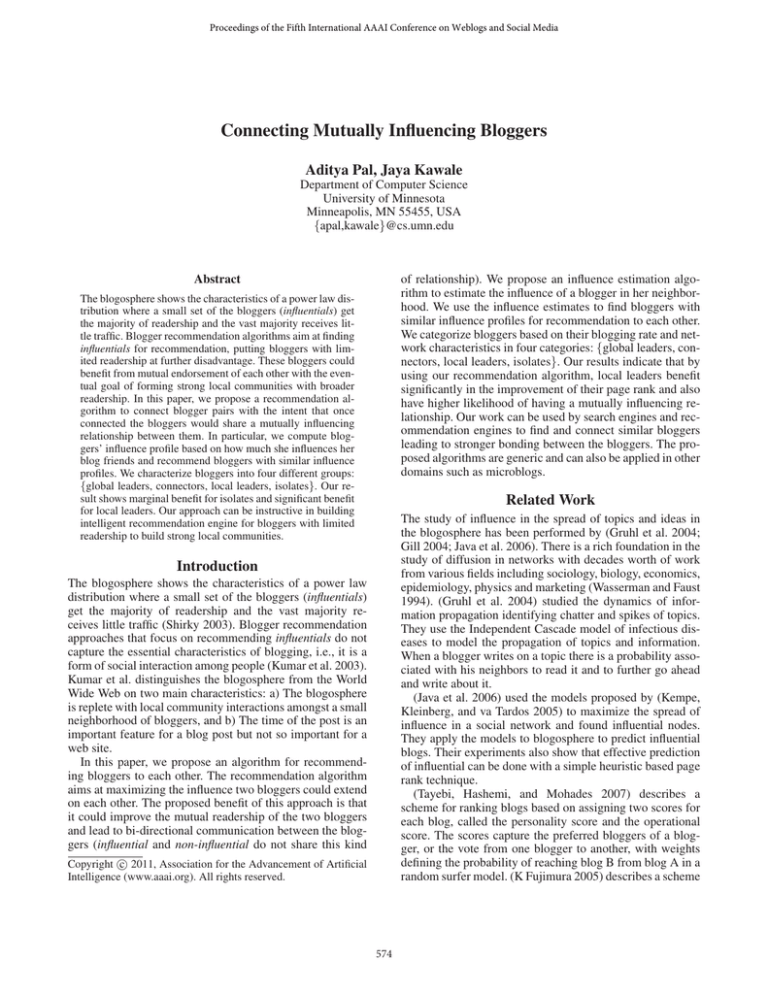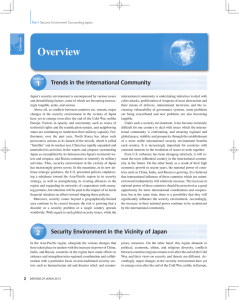
Proceedings of the Fifth International AAAI Conference on Weblogs and Social Media
Connecting Mutually Influencing Bloggers
Aditya Pal, Jaya Kawale
Department of Computer Science
University of Minnesota
Minneapolis, MN 55455, USA
{apal,kawale}@cs.umn.edu
of relationship). We propose an influence estimation algorithm to estimate the influence of a blogger in her neighborhood. We use the influence estimates to find bloggers with
similar influence profiles for recommendation to each other.
We categorize bloggers based on their blogging rate and network characteristics in four categories: {global leaders, connectors, local leaders, isolates}. Our results indicate that by
using our recommendation algorithm, local leaders benefit
significantly in the improvement of their page rank and also
have higher likelihood of having a mutually influencing relationship. Our work can be used by search engines and recommendation engines to find and connect similar bloggers
leading to stronger bonding between the bloggers. The proposed algorithms are generic and can also be applied in other
domains such as microblogs.
Abstract
The blogosphere shows the characteristics of a power law distribution where a small set of the bloggers (influentials) get
the majority of readership and the vast majority receives little traffic. Blogger recommendation algorithms aim at finding
influentials for recommendation, putting bloggers with limited readership at further disadvantage. These bloggers could
benefit from mutual endorsement of each other with the eventual goal of forming strong local communities with broader
readership. In this paper, we propose a recommendation algorithm to connect blogger pairs with the intent that once
connected the bloggers would share a mutually influencing
relationship between them. In particular, we compute bloggers’ influence profile based on how much she influences her
blog friends and recommend bloggers with similar influence
profiles. We characterize bloggers into four different groups:
{global leaders, connectors, local leaders, isolates}. Our result shows marginal benefit for isolates and significant benefit
for local leaders. Our approach can be instructive in building
intelligent recommendation engine for bloggers with limited
readership to build strong local communities.
Related Work
The study of influence in the spread of topics and ideas in
the blogosphere has been performed by (Gruhl et al. 2004;
Gill 2004; Java et al. 2006). There is a rich foundation in the
study of diffusion in networks with decades worth of work
from various fields including sociology, biology, economics,
epidemiology, physics and marketing (Wasserman and Faust
1994). (Gruhl et al. 2004) studied the dynamics of information propagation identifying chatter and spikes of topics.
They use the Independent Cascade model of infectious diseases to model the propagation of topics and information.
When a blogger writes on a topic there is a probability associated with his neighbors to read it and to further go ahead
and write about it.
(Java et al. 2006) used the models proposed by (Kempe,
Kleinberg, and va Tardos 2005) to maximize the spread of
influence in a social network and found influential nodes.
They apply the models to blogosphere to predict influential
blogs. Their experiments also show that effective prediction
of influential can be done with a simple heuristic based page
rank technique.
(Tayebi, Hashemi, and Mohades 2007) describes a
scheme for ranking blogs based on assigning two scores for
each blog, called the personality score and the operational
score. The scores capture the preferred bloggers of a blogger, or the vote from one blogger to another, with weights
defining the probability of reaching blog B from blog A in a
random surfer model. (K Fujimura 2005) describes a scheme
Introduction
The blogosphere shows the characteristics of a power law
distribution where a small set of the bloggers (influentials)
get the majority of readership and the vast majority receives little traffic (Shirky 2003). Blogger recommendation
approaches that focus on recommending influentials do not
capture the essential characteristics of blogging, i.e., it is a
form of social interaction among people (Kumar et al. 2003).
Kumar et al. distinguishes the blogosphere from the World
Wide Web on two main characteristics: a) The blogosphere
is replete with local community interactions amongst a small
neighborhood of bloggers, and b) The time of the post is an
important feature for a blog post but not so important for a
web site.
In this paper, we propose an algorithm for recommending bloggers to each other. The recommendation algorithm
aims at maximizing the influence two bloggers could extend
on each other. The proposed benefit of this approach is that
it could improve the mutual readership of the two bloggers
and lead to bi-directional communication between the bloggers (influential and non-influential do not share this kind
c 2011, Association for the Advancement of Artificial
Copyright Intelligence (www.aaai.org). All rights reserved.
574
Figure 2: Scatter plot of bloggers in different categories (image is zoomed for better visualization).
Figure 1: Log-Log plot of degree distribution of core nodes.
based on pagerank (Brin and Page 1998) to rank blogs and
bloggers.
Our work differs from the prior work as it aims at recommending bloggers such that they share mutually influencing relationship in future. We present an influence estimation algorithm for connected bloggers that considers the
blogs posts as causal links where one influences the other
and measure the actual influence of a post on another using document similarity measures over temporally ordered
posts. The proposed methodology could improve the bonding between bloggers in the long tail and lead to the formation of strong communities.
• Global Leaders: Bloggers with high blogging rate and
high page rank. These are the top influential bloggers who
publish blogs frequently.
Dataset
• Isolates: Bloggers with low blogging rate and low page
rank. Not many people connect with these bloggers and
they are typically registered to follow other bloggers and
post comments.
• Connectors: Bloggers with low blogging rate but high
page rank. These bloggers are influentials yet they do not
post as frequently as global leaders. Typically, celebrities
and other famous people lie in this category. They do not
blog very often yet enjoy a very high follower count.
• Local Leaders: They are bloggers who post frequently
but are not as important as global leaders. They are bloggers who enjoy readership in their local community and
are motivated towards publishing blogs.
We crawled LiveJournal blog graph by choosing 5 popular
bloggers1 as seed. The resulting directed graph contained
528,029 nodes, 2,113,724 edges and 2,000 core nodes. Core
nodes are nodes whose neighbors and neighbors’ neighbors
are present in the crawled graph. Figure 1 shows the degree
distribution of the core nodes. The plot resembles a powerlaw distribution with a skew towards the tail. For all the
nodes, we collected their blogs during March 2009 - June
2009 (4 months). We collected 9,578,030 blogs with an average of 18 blogs per blogger.
Our Algorithm
The blogosphere is represented as a directed weighted graph
G(V, E), where V represents the set of bloggers and E represents the set of directed edges between them. The directed
edge y → x indicates ”x reads y”. A blogger x is considered
to be reading blogger y’s blogs if x friends y, comments or
cites y. The weight I of the directed edge y → x indicates
”influence of y on x” and is written as I(y, x).
Blogger Categorization
We categorized the core nodes into four different categories
based on their blogging rate and graph prominence. We selected page rank (Brin and Page 1998) as a feature to measure the prominence of a given node in the blog graph. Page
rank algorithm looks at how the nodes are interconnected
and their relative importance to compute iteratively the page
rank of each node. We calculated blogging rate as average
number of blogs written by the user in a month. It gives us
an estimate of how engaged is the person in the blogging.
We computed the mean of page rank and blogging rate for
all the core nodes and partitioned them into four categories
based on the two mean values. Figure 2 shows the scatter
plot of users in the four categories. The four categories are
defined as follows:
1
Mutually Influencing Relationship (MIR)
Mutually influencing relationship (M IR) is based upon
mutual endorsements. The relationship between an influential and a non-influential blogger is non-mutual as the
non-influential blogger reads the influential blogger’s blogs,
comments, cites or bookmarks it, but the influential blogger
does not reciprocate the same. On the other hand there are
various communities among the long tail of bloggers that
thrive on mutual following of each others’ blogs. M IR is a
bi-directional relationship between two connected bloggers
x,y, s.t. they influence each other approximately equally.
The bloggers x and y must satisfy the constraint Mτ (x, y) :
I(x,y)
1
τ ≤ I(y,x) ≤ τ , where τ is the approximation threshold.
http://en.wikipedia.org/wiki/List of LiveJournal users
575
Algorithm 1 Influence Estimation Algorithm
Algorithm 2 Recommendation Algorithm
Require: blog posts P : {p1 , p2 , .., pn }, sorted on publish time
in non-decreasing order. T (pi ) indicates the time of the post.
DS(pi , pj ) computes document similarity.
for i : 1 to n do
u : user(pi )
U : u ∪ in-neighbors(u)
pl : latestpost(u) {latest post published by ui before pi }
Require: influence estimates {I(x, y) : ∀x, y ∈ V }. τ is approximation threshold for M IR. cat(u) is one the four categories to
which blogger u belongs. W is a vector with three components,
s.t. the sum of the components is 1.
for u ∈ all-users do
U : in-neighbors(u)
V : out-neighbors(u)
out(u) : v∈V I(u, v)
|
]
Ipr(u) : [I(u, u) out(u) |V
|U |
end for
{ps: post influence set}
ps : {p ∈ P : (user(p) ∈ U ) ∧ (T (pl) ≤ T (p) < T (pi ))}
{update influence estimates}
for v ∈ U do
{I(v, u) : 0, if not defined
previously}
p∈ps∧user(p)=v [1 + DS(p, pi )]
I(v, u) : I(v, u) +
p∈ps [1 + DS(p, pi )]
end for
end for
{normalize influence estimates}
for u ∈ all-users do
n : num-posts(u)
U : u ∪ in-neighbors(u)
for v ∈ U do
{ v∈U I(v, u) = 1}
I(v, u) : I(v,u)
n
end for
end for
R(u, v) : [Ipr(u) − Ipr(y)] · W, ∀u, v ∈ V
for u ∈ all-users do
U : in-neighbors(u)
V : out-neighbors(u)
/ U ∪V ∧cat(v) = cat(u)}
y : arg minv {R(u, v) ≤ τ : ∀v ∈
{if y exists, then create edges: u → y, y → u}
end for
Isolates
Local Leader
Connector
Global Leader
I
LL
C
GL
I
.2
LL
.04
.42
C
.05
.02
.14
GL
.06
.08
.13
.17
Table 1: Likelihood of M1.5 satisfiability for two bloggers
in various categories.
Influence Estimation Algorithm
Likelihood of Mutually Influencing Relationship
We use the observation that blog posts are often the result of
social interactions at the local level. A blogger draws influence from her blogger friends and vice-versa. The influence
estimation algorithm presented by Algorithm 1 begins by
constructing a post influence set (ps) which contains blog
posts in u’s neighborhood which could have influenced u to
publish pi . ps contains all the posts published by u’s friends
(including u) between two consecutive posts of u. For all the
posts in ps we estimate the influence on pi by computing
their document similarly (DS). document similarity is computed by turning blog posts into tf -idf vectors and taking
cosine similarity measure of the tf -idf vectors. Influences
are then normalized with the constraint that each user draws
a influence of 1 from her neighborhood.
We compute the influence estimates between users and estimate the probability of M1.5 satisfiable relationships for
core nodes (see Table 1). As expected, this probability is
higher for bloggers in the same categories than across categories (one way t-test with p < 0.001) - justifying the claim
that ties between an influential and a non-influential blogger
are unidirectional with asymmetric flow of influence. The
likelihood of M IR for LL users is highest indicating that
they participate in mutual endorsements more than users of
any other category.
Performance of Recommendation Model
One recommendation is generated per core node. If a node is
already recommended then another recommendation including that node is discarded. Overall this leads to a generation
of less than 1000 recommendation for the 2000 core nodes.
To measure the model performance, we hold out 20% of the
most recent blogs and use the remaining 80% of the blogs
for influence estimation. Once recommendations are added
to the graph, the hold out blogs (20%) are used to recompute estimation and test Mτ satisfiability of the edges added
by the recommendation algorithm. Precision is calculated as
the ratio of Mτ satisfiable recommendations by all the recommendations.
We choose two baseline algorithms: a) Random recommendation of users within the same category, b) Document
similarity model, which computes average document similarity DS(., .) of all the blog post pairs of the two bloggers
and picks blogger pairs with highest similarity for recom-
Recommendation Algorithm
Recommendation algorithm (see Algorithm 2) aims to find
bloggers that if connected would share a M IR between
them. To do this, we first compute the user’s influence profile (Ipr) containing three components: 1) Self-influence,
2) Influence of the user on her friends, 3) Ratio of her out
degree with in-degree. Algorithm then uses the hypothesis
that: bloggers with similar influence vectors are more likely
to have a M IR, to find bloggers within same category that
have closest influence profile (under τ approximation).
Results
Our algorithm has two parameters, τ , W . We experimented
with several values of them and choose the ones that perform
the best (τ = 1.5, W = [.2 .5 .3]T ).
576
Figure 3: Category wise change in the page rank of bloggers after using our recommendation algorithm.
Category
Our recommendation model
Document Similarity
Random recommendations
I
.47
.32
.13
LL
.73
.48
.37
C
.55
.35
.15
GL
.56
.38
.15
Table 2: Precision of different models.
mendation. Table 2 shows that our model improves over the
best baseline models by 46-57%. This increase in performance is substantial. High precision for LL indicates that
our model can find blogger pairs that would exhibit mutual
relationship (indicator of high activity correlation and document similarity).
Figure 4: Change in Average Page Rank with our recommendation model compared to document similarity model.
Measuring Changes in Page Rank
We measure the changes in page rank of nodes before and
after the application of the recommendation algorithm to see
how the recommendations affect nodes’ graph prominence.
The aim here is to see how the prominence of users would
vary in the real world if they were to follow the recommendations proposed by our algorithm. The recommendation algorithms are run for 30 iterations and in each iteration
the graph is updated as per the recommendations. Figure 3
shows that the page rank increases for bloggers in long tail if
they are effectively connected and it could lead to decrease
in the prominence of influentials.
Figure 4 shows that comparative change in page rank of
our vs document similarity model . It shows that the increase
obtained from using our models is more than 25% for LL
and 14% for I for 20-25 iterations. This indicates that effective connections of the users between categories can lead
to significant improvements in their page rank (used as an
indicator of readership).
to retain people by recommending them to each other and
enable the scope of mutual endorsements.
References
Brin, S., and Page, L. 1998. The anatomy of a large-scale
hypertextual web search engine. Computer Network ISDN
Systems 30(1-7):107–117.
Gill, K. E. 2004. How can we measure the influence of
the blogosphere? In WWW: workshop on the Weblogging
Ecosystem: Aggregation, Analysis and Dynamics.
Gruhl, D.; Guha, R.; Liben-Nowell, D.; and Tomkins, A.
2004. Information diffusion through blogspace. In WWW,
491–501.
Java, A.; Kolari, P.; Finin, T.; and Oates, T. 2006. Modeling
the spread of influence on the blogosphere. Technical report.
K Fujimura, T Inoue, M. S. 2005. The eigenrumor algorithm
for ranking blogs. In WWW, Workshop on the Weblogging
Ecosystem.
Kempe, D.; Kleinberg, J.; and va Tardos. 2005. Influential
nodes in a diffusion model for social networks. In ICALP,
1127–1138.
Kumar, R.; Novak, J.; Raghavan, P.; and Tomkins, A. 2003.
On the bursty evolution of blogspace. In WWW, 568–576.
Shirky, C. 2003. Power laws, weblogs, and inequality.
Tayebi, M. A.; Hashemi, M. S.; and Mohades, A. 2007.
B2rank: An algorithm for ranking blogs based on behavioral
features. In WI, 104–107.
Wasserman, S., and Faust, K. 1994. Social Network Analysis: Methods and Applications. Cambridge University Press.
Conclusion
In this paper, we present a novel approach to recommend
bloggers based on their influence profiles. We show that
bloggers in the long tails could be effectively connected to
create strong bonds between the connected users. We hypothesize that this could improve their readership and motivation to blog and formation of strong local communities.
Our work can be instructive for recommendation engines
for providing effective recommendations to the users in blogosphere and other similar domains like microblogs. We aim
to test our findings on microblog users in future work. It can
also be useful for community managers to develop methods
577



